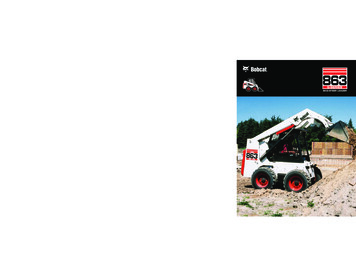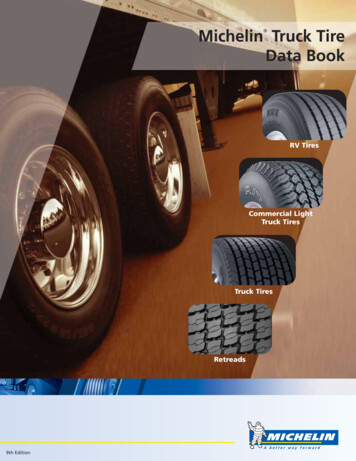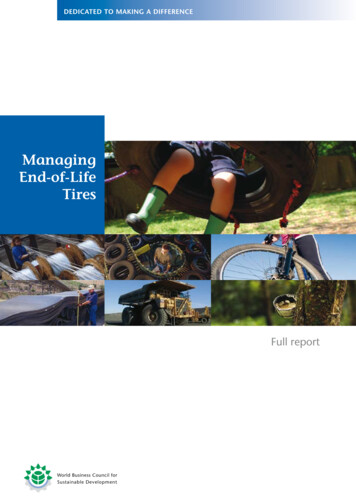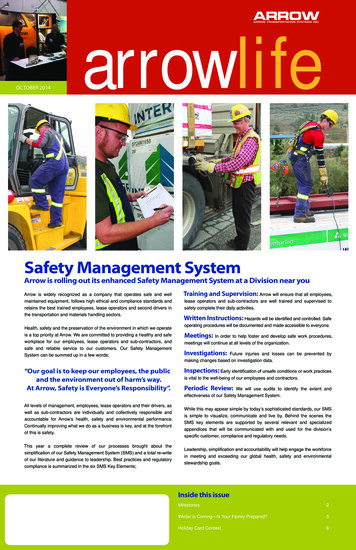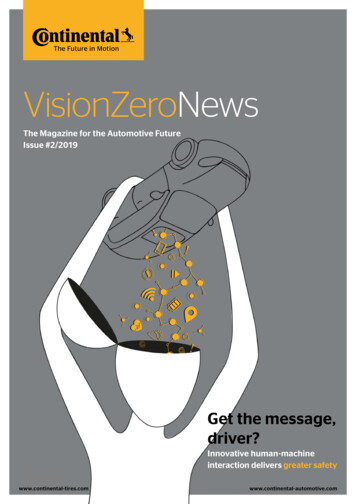
Transcription
VisionZeroNewsThe Magazine for the Automotive FutureIssue #2/2019Get the message,driver?Innovative human-machineinteraction delivers greater omotive.com
VisionZeroNewsThe Magazine for the Automotive Future. Issue #2/2019Transforming trucksDigitalization, electrification, automation10Freedom ontwo wheelsThe motorcycle industryis booming, and moreand more bikers aretaking to the roadsas spring arrives154Get the message,driver?Interview withGuido Meier-Arendt,Principal Expert forWhat’s the airquality like?Ask a street lampHuman-Machine8NEWSInterfaces atContinental14New 5G hybrid V2Xplatform for high-speeddata exchange18Did you know . that seat belts were invented in Sweden?
4 Vision Zero — GET THE MESSAGE, DRIVER?Vision Zero — GET THE MESSAGE, DRIVER? 5Get the message,driver?ding information must immediately appear on the display or therecreate an attractive experience that allows users to seamlessly re-must be a voice message warning the driver that a lane departuresume the communication or entertainment activity of their choiceis imminent, for example.during automated driving. User-centered design is key to creatingsolutions that reflect users’ needs.What are the biggest challenges in designing human-machineinterfaces, or ‘HMI solutions’?What exactly do you mean by user-centered design?Creating attractive user experiences. The challenges are particu-It’s no good having a new system or new technology that lookslarly apparent in the field of automated driving. On the one hand,great on paper if the interaction with the driver isn’t implementedyou have to meet the basic ergonomic requirements – for instance,in a user-friendly manner. We need solutions that can be operatedthe system must ensure that the driver is duly prepared to resumesimply and effectively, delivering a high standard of usability toge-control of the vehicle. At the same time, however, you need tother with an enhanced user experience.Vibrating steering wheels, flashing displays and beeps in thecockpit – driver assistance systems communicate in all sortsof different ways. Isn’t all this information confusing for drivers?Guido Meier-Arendt, Principal Expert for Human-Machine Interfaces at Continental, highlights the vital importance of carscommunicating clearly.Guido Meier-Arendt, today’s drivers aretion that they need in order to drive safelybombarded with everything from driverat the current point in time – no more andassistance system alerts to messages fromno less. Driver assistance systems employFacebook friends. Isn’t there a danger thatan inform-warn-intervene escalation strate-too much information could compromisegy in which the relevant information for thesafe driving?current escalation level is communicated toYou’re absolutely right, the volume of infor-the driver multimodally – visually, acousti-mation in our cars is growing constantly.cally and haptically.This makes it particularly important toGuido Meier-Arendtis Principal Expert forHuman-Machine Interfaces and Ergonomicsin Continental’s Interiordivision.develop smart solutions which ensure thatCouldn’t this be dangerous? What hap-interactions between drivers and their vehic-pens if drivers who are used to the interac-les are both user-friendly and above all safe.tion system of one particular make of carOnce we have ascertained exactly whichsuddenly find themselves confronted withinformation the driver requires in a given dri-different feedback systems when drivingving situation, we then need to package anda vehicle built by another manufacturer?communicate it in a user-friendly manner.That is a very valid point and is of coursesomething we are working on all the time.How do you do this?The solution is to develop self-explanatoryYou have to combine information fromhuman-machine interface designs whichdifferent driver assistance systems. Youdon’t do anything unfamiliar that could con-don’t need a separate vehicle-user interfacefuse drivers accustomed to a different formfor every single system. For instance, weof communication. The car must communi-look for clever ways of combining adaptivecate clearly – every relevant system in thecruise control and lane control informationvehicle must send messages that are unam-to enable intelligent priority management.biguous and easy to understand. WheneverThe driver should only receive the informa-the steering wheel vibrates, the correspon-Intelligent cockpit concepts will become increasingly importantin a future where cars drive autonomously.
6 Vision Zero — GET THE MESSAGE, DRIVER?Vision Zero — GET THE MESSAGE, DRIVER? 7What part does HMI play in Continental’svision of zero road accidents?It has a vital part to play. The goal is alwaysto improve traffic safety by ensuring genuinely intuitive collaboration between userand vehicle. At Continental, we have established a “search field” explicitly devoted tooptimizing the human-machine interface in“The goal is always to improve trafficsafety by ensuring genuinely intuitivecollaboration between user and vehicle.”line with users’ needs. We are also increa-Continental’s Integrated Cockpit System, which recently won the Germansingly adopting a user-centered design ap-Design Council’s Innovation Of The Year award, features large curved glassproach to ensure that our innovations andsurfaces with multiple displays and touchscreens is the average driverfuture technologies are precisely tailored toready for such futuristic cockpit designs?users’ wishes and needs. This user-centeredThere is no reason why an innovation like Continental’s Integrated Cockpit Sys-approach is in fact critical to the develop-tem shouldn’t succeed, given that it delivers direct, tangible benefits, enhan-ment and design of modern vehicles, whichces user comfort and above all improves safety. There is obviously no point inmakes it key to the achievement of ourproducing a flashy cockpit with futuristic aesthetics and all sorts of high-techVision Zero.bells and whistles if it ultimately fails to provide the important information inI can see clearly now: Continental has developed a virtual A-pillarthat enhances traffic safety by providing drivers with a clearer view.a user-friendly manner.In other words, you stick to the famous “form follows function”design principle?Exactly. It’s essentially the same problem as a designer chair that wins lots ofWhile strong A-pillars play an importantprizes but is really uncomfortable to sit on. So yes, we stick to the “form followsfunction” principle, or more accurately “form follows user requirements”. Thisin the areas that are hidden from their view.on between manual and automated drivingrole in optimizing crash safety, they alsoWith this system, they really can see every-in particular will call for completely newrestrict the driver’s field of view. Conti-thing that is going on – it is as if the A-pillarapproaches to the design of the human-is particularly important in vehicle cockpits, where we expect to see more andnental has come up with the idea of de-were transparent. To make this possible, anmachine dialogue. If the human driver ismore technological solutions tailored as flexibly as possible to specific contextsveloping a virtual A-pillar that the driverinterior camera tracks the driver’s head mo-no longer solely occupied with driving theof use, with customizable content enabling users’ individual wishes to be met.can see through vements to ensure that the display providesvehicle, their role becomes that of a criticalThe inclusion of large display surfaces is one way in which the Integrated Cock-This is a good example of an innovativea realistic perspective on what is happeninguser and supervisor in the cockpit. Thispit System responds to these challenges. So we took various consumer electro-proof of concept study that adds genuineoutside. At the same time, externally moun-makes it essential for them to always knownics trends into account in the system’s design, as well as asking ourselves whatvalue for users by eliminating the forwardted Surround View cameras generate a livewhat the vehicle is doing and which drivingwe needed to do to optimize the interactions on board the vehicle. One of theblind spot created by the A-pillar. There arevideo feed of the outside environment.mode it is in whenever the situation requi-solutions we came up with was to use haptic alerts. In other words, rather thanvarious road traffic situations where driverssimply fulfilling the basic ergonomic requirements, the cockpit also contributesare unable to see everything that is goingAutonomous driving is the next big thing.the driver’s role and the associated needsto a positive overall in-vehicle experience.on as well as they would ideally need to. OurBut it promises to be quite a challenge,and requirements constitute one of theproof of concept demonstrates how specialespecially for HMI developers greatest challenges in the development ofdisplays can show drivers what is happeningThis is a very important topic. The transiti-automated driving.res them to resume control. This change in
8 Vision Zero — NEWSVision Zero — NEWS 9NewsContinental helps tofind parking spacesworldwideWhat’s the air quality like? Ask a street lamp.The average driver in Germany spends 41What will life be like in the city of the future? One thing ishours a year in search of a parking space andfor sure: As time goes by, more and more people will livein countries like China that figure is presu-in urban spaces – and move around those spaces in largemably much higher. So what we need is anumbers of different vehicles. So it’s going to take inno-system that can solve the parking problem.vative technologies to prevent accidents and collisions. AtIn response, Continental is now rolling out itsthe recent Consumer Electronics Show (CES) in Las Vegas,parking data services worldwide, providingUSA, Continental showcased key technologies for the cityinformation about available off-street parkingof the future. Among other things, with the aid of virtualspaces. The global rollout is expected to bereality visitors were able to experience how the Intelligentcompleted by the end of 2019. The data isIntersection works. This system, currently being piloted insold in license packages to map providersWalnut Creek, California, involves direct communicationand carmakers, making it possible to reachbetween intersection and vehicle. For example, the systemdrivers directly via their on-board and navi-can warn an oncoming driver about a pedestrian crossinggation systems. The service offers real-timea street outside the driver’s line of sight. Continental alsooccupancy data from parking garages as wellpresented a new Intelligent Street Lamp concept: Usingas relevant information about prices, openingsecure connectivity and sensorics, this solution enableshours and electric charging stations. “Theremote light control as well as adaptive street lighting go-combination of our data sources and auto-verned by the presence of nearby road users. At the samemated quality assurance means that in ourtime, the street lamp can communicate data on air quality,core markets, we are able to achieve almosttraffic levels, hazards or available parking spaces.Online PaymentOn – StreetOff – Streetcar park ahead300m – 53 spotsdetectingspotstotal coverage in cities of more than 25,000inhabitants with more than 70,000 pointsof interest,” said Jürgen Schweiger, Head of“Map&Parking” at Continental’s ITS segment.Door system from Continentalscoops Innovation AwardArtificial intelligence: Continental cooperatingwith Berlin-based start-upModern cars are becoming smarter and smarter – now even the doorsare getting in on the act. Continental has developed an intelligent doorsystem that prevents you from opening the door without thinking, ifthere is an obstacle approaching or in the way. This new technologyContinental is cooperating with German start-to create virtual environments based on HDled to Continental being recognized by the US Consumer Electronicsup company Automotive Artificial Intelligencemaps and artificial intelligence. The start-up isAssociation as a CES 2019 Innovation Award winner in the Vehicle(AAI) on the virtual development and simula-responsible for simulating the environment,Intelligence and Self-Driving Technology category. Technologies suchtion of driver assistance systems and automa-providing software that enables vehicles toas the intelligent door brake system and the smart autonomous doorted driving technologies. Virtual developmentbe driven in a virtual world. The aim is to dohelp to make opening and closing the door comfortable and conve-already plays an integral part in the modernjustice to the increasingly broader scope ofnient, while preventing the uncontrolled slamming of vehicle doors.product development process. Now, togethervalidation in automated driving. Continental in-At the same time, their obstacle detection capability leads to greaterwith AAI, Continental is developing a highlytends to make the simulation tools developedsafety in traffic scenarios. The smart autonomous door system is also ascalable, highly modular development andwithin this collaboration available to the entireprerequisite for automated driving. After all, driverless vehicles must betesting environment. AAI, founded in Berlin inautomotive industry.able to open and close their doors when there’s no one around and no2017, brings to the table the expertise requireddoor handles, come to that.
10 Vision Zero — TRANSFORMING TRUCKSVision Zero — TRANSFORMING TRUCKS 11Photo: Continental / istockphoto.comTransforming trucksThe car industry megatrends of digitalization, electrification and automation are also shaping the development of trucks and buses. Continental’sinnovations are constantly raising the bar for safety and connectivity.times a second by a powerful computer known as the Assisted andAutomated Driving Control Unit (ADCU). This means that the vehicle’selectronic systems can “see” things like a vehicle approaching on theother side of the road, another vehicle 200 meters up ahead in thesame lane, or a car pulling out to overtake.The safety benefits are enormous – the fact that the vehicle has aclear picture of the environment it is driving through ensures optimaloperation of its assistance systems. The environment model is also keyto enabling different automated driving functions such as platooning,where multiple digitally coupled trucks drive in convoy. This technologymakes life easier for the drivers of the trucks following the convoy’s leadvehicle and cuts emissions by reducing fuel consumption.The CEOs of the major automakers like to talk about “reinventing thetruck manufacturers meet these challenging targets, Continental has“The environment model rounds off Continental’s portfolio of com-automobile” when referring to the rapid pace of technological progressdeveloped numerous innovations that will make tomorrow’s commer-ponents and subsystems for vehicle environment detection. With ourin the car industry. But things are no different in the commercial vehic-cial vehicles more efficient, smarter, safer and eco-friendlier.sensors, our applications for vehicle connectivity and our intelligentles sector, where the “reinvention of the truck” has been in full swing forcontrol units for automated driving, Continental will in future be in asome time now. This trend has been further accelerated by the recentThe environment model currently being developed by Continental isposition to offer its customers everything they need for the reliableadoption of new EU regulations for reducing CO2 emissions. Trucks willone example. The system models the vehicle’s environment by com-detection of the vehicle environment – from a single source,” said Jörgbe required to cut their CO 2 emissions by 15 percent from 2025 andbining route data with data from sensors such as cameras, radar andLützner, Head Commercial Vehicles, Division Interior, Systems and30 percent from 2030, compared to the average level for 2019. To helplidar. The acquired data is analyzed and interpreted more than fiftyTechnology at Continental.As well as developing gas-powered and electric vehicles, truck manufacturerslike Volvo are also working on aerodynamic enhancements in order to reduceCO 2 emissions. The Volvo Concept Truck delivers fuel and emission savings ofup to 30 percent.
12 Vision Zero — TRANSFORMING TRUCKSVision Zero — TRANSFORMING TRUCKS 13The right turn assistant (in left-hand drive vehicles) is another of thetype for the development of tires designed specifically for electricenvironment model’s concrete uses. Continental will be augmentingcommercial vehicles. As Klaus Kreipe, Head of Original Equipmentfuture versions of this radar-based system with camera technology.Truck Tires at Continental, explains, “The new powertrains and theThe right turn assistant aims to prevent collisions between buses ornew vehicle concepts that are sometimes associated with them willtrucks making a right turn and pedestrians or cyclists in the blind spotchange the requirements for commercial vehicle tires. We are cur-on the right-hand side of the vehicle. In the past, this maneuver hasrently engaging in partnerships to gain valuable experience for theresulted in multiple fatal accidents involving pedestrians and cyclists.development of tires for electric trucks and buses.”The right turn assistant detects hazardous situations and instantly activates emergency braking to prevent a collision. The EU is currentlyWith these innovative systems, Continental is playing a decisive partdiscussing the mandatory installation of these systems. The enhancedin shaping a future with lower emissions. One system that can alreadyright turn assistant could represent an important step towards theContinental supplies a modular driver’s workplace forcity buses. The image shows the individual modules,which can be combined in accordance with the customer’s needs and preferences.“Vision Zero” goal of zero road traffic fatalities.Other Continental innovations are also geared toward achieving this‘see’ into that future is dynamic eHorizon for commercial vehicles. Based on ultra-precise topographical route data and GPS signals, the system supplies all kinds of information about the road ahead, enabling thecontrol units in the vehicle to automatically adapt the speed and stylegoal. One example is the modular digital bus cockpit, designed to pro-of driving. In the near future, vehicles equipped with dynamic eHorizonvide bus drivers with improved ergonomics, comfort and thus safety inwill be able to ‘see’ for kilometers ahead. This will not only save fuel buttheir daily work. The drivers of these large vehicles are constantly beingalso prevent accidents, for instance by warning of a tailback hiddenbombarded with information. The modular cockpit enables this infor-around a bend. The predecessor system, static eHorizon, has alreadymation to be communicated clearly and without distracting the driver.been able to save some 1 billion liters of diesel fuel since 2012, whichBe it the speed of the vehicle, the battery status or the satnav, imagesour new concept, we are opening a new chapter in the history of theequates to savings of the order of 1 billion. And simulations indicatefrom the door cameras at stops or 360-degree vision when reversing,driver’s workplace, putting people at the heart of everything we do.”that the dynamic version has the potential to increase fuel savings bythe drivers are supplied with all the relevant information on threeas much as two percent.displays. Pop-up messages can be flashed onto the displays to warnTires will of course also play a key role in helping to deliver the EUthe driver of hazards or emergencies. This solution can be installed onemissions targets. The IAA Commercial Vehicles show held in Hano-almost any city bus and has already won the iF Product Design Awardver in the fall of last year saw the global premiere of both the MANand the German Design Award. According to Michael Glunk, ProgramCitE electric truck and the striking Continental concept tires that itManager for the modular driver’s workplace at Continental, “Withwas fitted with. The four Conti e.MotionPro design tires are a proto-Continental’s rightturn assistant detectspedestrians or cyclistswho might not be seenat all or spotted too lateby truck or bus driversmaking a right turn.The system is primarilyaimed at preventing accidents in urban areas.A black and blue color scheme and a unique profile: The Conti e.MotionProdesign tires were handmade at the Púchov plant in Slovakia, while the treadwas created using a robotic cutting process before being finished by handin Stöcken, Hanover.
14 Vision Zero — NEWSVision Zero — FREEDOM ON TWO WHEELS 15NewsFreedom on two wheelsNew 5G hybrid V2X platformfor high-speed data exchangeCars that can ‘talk’ to one another, adaptive driver assistance systems,The motorcycle industry is booming, and more and more bikers are taking to the roadsas spring approaches. New technology is helping to make motorcycling not only saferand more comfortable, but also boosting the fun factor. Continental’s new EmergencyBrake Assist is a case in point.active road signs . the innovative technologies on and around ourroads all mean one thing: much more data. To ensure the fluent exchange of all this data in real time will call for powerful mobile networks.Continental is currently developing a flexible 5G hybrid V2X (Vehicle toEverything) platform that allows both mobile network communicationand the rapid and reliable direct exchange of data to communicatereal-time traffic updates and road hazards, for example, and underpinfuture driver assistance functions. Continental’s Hybrid V2X solutionnot only integrates technologies for 4G and 5G network access, butalso supports two standards Dedicated Short-Range Communication(DSRC) and Cellular-V2X for direct V2X communication. With this newhybrid V2X solution, the same hardware and software platform can beused to support either standard, reducing not only the cost but also thecomplexity of the global application of such systems.Smart wearables make life saferPhoto: istockphoto.comThat’s a smart jacket you’re wearing . in more ways thanone. Because now, digitalization has come to the clothingsector. Intelligent items of clothing or ‘smart wearables’ forshort, are making life safer out on the roads. ContinentalGreen shoots are out in the fields of rapeseed, and soon thethan half a million on 2010. And one of the reasons for the rising popu-recently presented an actively illuminated safety jacketcountryside will be ablaze with bright yellow flowers. The lastlarity of motorcycles is that they are getting safer all the time.with LEDs that light up and an integrated heating function.snow of a long winter is thawing on the high ground, andThe batteries for the LEDs and the heating are charged byherds of cattle are returning to lush green pastures. TablesThe growing impact of digitalization, a major mobility trend, is makinga coil incorporated in the driver’s seat. And looking ahead,and chairs are being placed in the sunshine outside countryitself felt on the motorcycle market too. Increasingly bikes are being fit-there are opportunities for further interaction between thisinns. In other words, spring is here with all its joys – whichted with assistance systems to make them even safer. At the same time,innovative jacket and the vehicle electronics: For one thing,include eager anticipation of the first outing of the newbetter and better tires for every conceivable type of use are deliveringsensors in the jacket could measure the temperature andbiking year. An entire industry is waiting for the start of whata marked increase in safety. But one of the key factors is connectivity,humidity in the cab and automatically adjust the climatepromises to be a record season. In Germany alone – one ofwhich is pointing the way forward for the industry. “Communicationcontrol system accordingly. For delivery drivers, emer-Europe’s most important motorcycle markets – there arebetween motorcycles or between motorcycles and other road users”gency vehicle or utility service crews and truckers, smartmore motorbikes registered than ever before. According tois, according to Reiner Brendicke, CEO of the Association of Germanwearables can make their work a whole lot safer by makingofficial figures from the Federal Motor Transport AuthorityMotorcycle Manufacturers (IVM), essential to ensure traffic safety. “Thisthem much easier for other road users to see in hazardousKBA, some 4.44 million motorcycles were registered as ofis particularly relevant for us as motorcyclists, as many accidents hap-situations or poor visibility.January 1, 2019 – and that does not include mopeds andpen because motorists fail to spot approaching motorcycles.” This willother motorized two-wheelers. This is an increase of morebecome increasingly critical as more driverless cars take to the roads.
Vision Zero — FREEDOM ON TWO WHEELS 1716 Vision Zero — FREEDOM ON TWO WHEELS“There won’t be any scenarios in whichRoad sign recognitionconventional or electric motorcycles driveThe new Advanced Rider AssistanceSystem from Continental identifiesthe speed limit and informs the rideraccordingly.autonomously,” says Brendicke. “But webikers will be sharing the road with highlyautomated, self-driving cars and trucks. Sofor our own safety, our bikes will need to beable to communicate with other vehicles.”Continental is also following this trend. Thecomplete control. Continental’s accident research reveals that an Emer-technology company is aiming to be the firstgency Brake Assist system can prevent most rear-end collisions – andsupplier to market an Emergency Brake As-in the near future, even side-on or head-on collisions, too.sist for motorcycles. The radar-based systemforms part of a wide range of Advanced Rider“Unlike car drivers, motorcyclists have virtually no protection againstAssistance Systems (ARAS) from Continental.environmental factors such as wind, weather and vibration – factorsThe new fifth generation of radar sensorsthat can make for a very challenging ride. As a result, bikers often findfrom Continental, characterized by – amongthemselves in situations where it is hard for them to judge the speed ofother things – an enhanced object recogniti-other vehicles on the road. So motorcycle Emergency Brake Assist ison capability, clears the way for a particularlymainly indicative: It alerts the rider to critical situations and makeshigh-performance Emergency Brake Assist.them easier to grasp more quickly,” says Christian Pfeiffer, ARAS projectAnd while the development of the system forleader for the 2-Wheeler & Powersports segment at Continental. “Likemotorcycles benefitted from Continental’sin a car, this system too will reduce the speed, but the aim is to trigger along experience in the design and construc-process which is then controlled by the rider. Response times are redu-tion of safety systems for cars and trucks,ced and the overall stopping distance can be significantly shorter.”there are still some differences: Where thecar’s Emergency Brake Assist autonomouslyContinental has also developed numerous other Advanced Rider Assis-triggers an emergency stop with full brakingtance Systems. These include Intelligent Adaptive Cruise Control, whichpower when a collision is imminent, the motor-adapts the speed of the motorcycle to that of the vehicle in front. Alsobike system brakes much more gradually. It isin the development pipeline are Blind Spot Detection & Lane Changedesigned to help the rider rather than takingAssist and Traffic Sign Assist, as well as Intelligent Headlight Assist,which ensures that high beam is automatically selected wheneverpossible and necessary. All systems are modular, so Continental canprovide customized solutions that meet the special requirements ofindividual markets. In Asian countries in particular, where motorizedtwo-wheelers are often the preferred everyday mode of transportation,these systems have the potential to deliver a significant increase in safety.Tires also have a vital part to play in accident prevention, and a rangeof innovative tire technology is providing bikers with additional safety.By way of example, to coincide with the start of the new season, Continental is launching its ContiTrailAttack 3 – the ideal tire for both longdistance touring and urban riding. Riders of a variety of machines willbenefit: The new tire covers a very wide range of applications, from theclassic Enduro to the likes of the BMW R 80 Basic, or from high-performance tourers such as Honda’s Africa Twin to the thoroughbredHeadlight AssistKawasaki Z 900 superbike. The tire reaches its operating tempera-This new intelligent system activates highbeam automatically whenever required.ture after only 1,500 meters and, thanks to Continental’s innovative“TractionSkin” technology, requires a minimum of running-in time.The selected compound and modified tread pattern deliver evenThe ContiTrailAttack 3 tire reachesits operating temperature after only1,500 meters and offers two-wheelerenthusiasts significantly higherlevels of comfort and safety.better wet-weather grip, along with high reliability throughout theservice life of the tire.Emergency Brake AssistThe newly developed Emergency Brake Assistsystem helps the rider through carefully dosedapplication of the brakes when a rear-impactcollision threatens.
18 Vision Zero — DID YOU KNOW .Vision ZeroVision— WUSSTENZero — SIEDIDEIGENTLICHYOU KNOW . 19Did you know . that seat belts wereinvented in Sweden?The topic of safety has never been far from the top of the agenda in Sweden.The domestic car industry has a reputation for turning out particularly robustmodels, and no wonder, given that around every corner there could
car park ahead 300m - 53 spots detecting spots On - Street Online Payment Off - Street Door system from Continental scoops Innovation Award Modern cars are becoming smarter and smarter - now even the doors are getting in on the act. Continental has developed an intelligent door system that prevents you from opening the door without .


